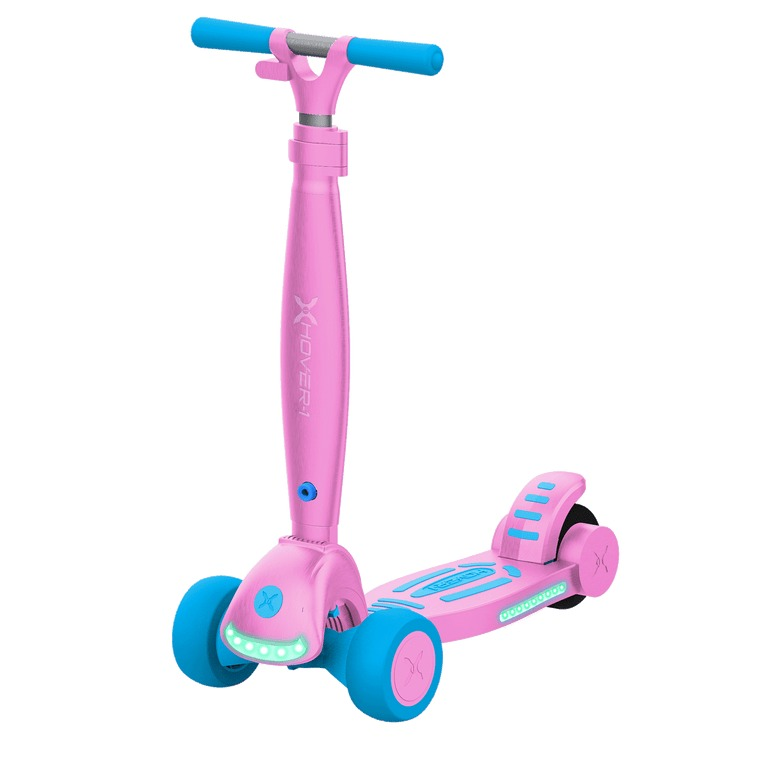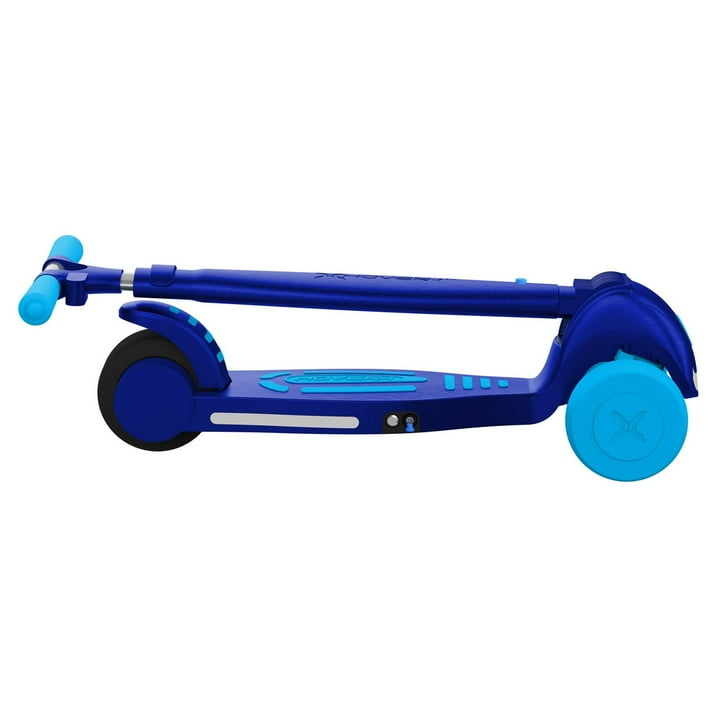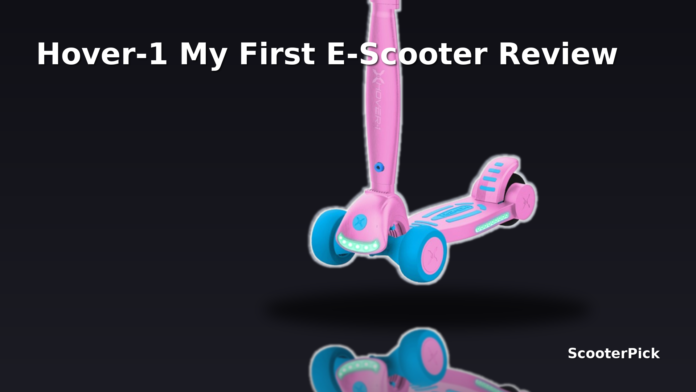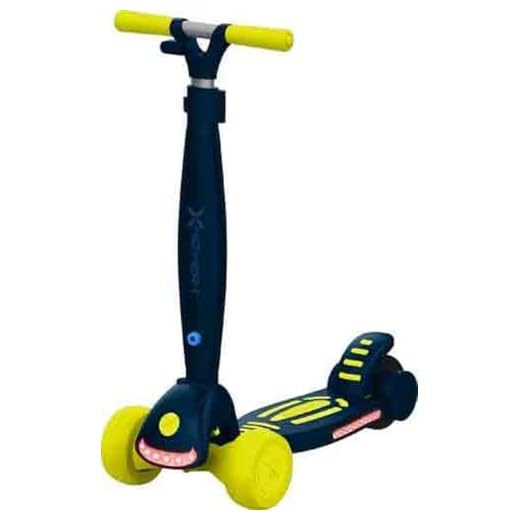Kids’ scooters don’t need to be fast to be fantastic. Instead, the Hover-1 My First E-Scooter aims for confidence, not adrenaline, with a low top speed, a three-wheel stance, and simple controls that help new riders learn at their own pace. In this Hover-1 My First E-Scooter review, we’ll break down how it’s built, how it rides, and what families can expect day to day. For full product details, see Hover-1 My First E-Scooter.
Hover-1 My First E-Scooter review — Quick Take
To begin, this model is a true “first e-scooter.” It deliberately trades power and range for stability, predictability, and fun lights that make kids smile. Consequently, the 80 W rear hub motor feels gentle and approachable. The deck sits low, and the three-wheel setup helps new riders stand, push, steer, and throttle without wobble. Moreover, it folds for the trunk and weighs about as much as a large laptop bag. If your goal is a safe, simple starter that rewards good habits, this one fits.
Key Specifications
Below are the key facts families ask about, listed with both U.S. and metric units for quick comparison.
General
| Item | Details |
|---|---|
| Model | H1-MFSC |
| Top speed | Up to 6 mph (≈ 9.7 km/h) |
| Claimed range | Up to 2 miles (≈ 3.2 km) per charge |
| Rider weight | Min 44 lb (≈ 20 kg) to Max 80 lb (≈ 36 kg) |
| Scooter weight | 10.6 lb (≈ 4.8 kg) |
| Wheel configuration | 3-wheel (dual front, single rear) |
Performance & Power
| Item | Details |
|---|---|
| Motor | 80 W rear hub motor |
| Drive | Rear-wheel hub |
| Throttle | Simple push-button electronic throttle |
| Hill guidance | Gentle slopes only; designed for flat paths and driveways |
Charging & Electrical
| Item | Details |
|---|---|
| Battery | 14.4 V / 2.0 Ah lithium-ion (≈ 28.8 Wh) |
| Charge time | Up to 4 hours |
| Charger/port | 1-pin proprietary charge cable |
| Operating temp | 32–104 °F (≈ 0–40 °C) |
Build & Dimensions
| Item | Details |
|---|---|
| Tires | Front 4.5 in (≈ 114 mm), rear 3.5 in (≈ 89 mm), solid (no flats) |
| Frame/deck | Low deck height with wide footpad for balance |
| Handlebar | Height-adjustable steering column with locking clamp |
| Folded size | 23.7 × 12.6 × 32.5 in (≈ 60.2 × 32.0 × 82.5 cm) |
| Folding | Quick latch with folding lock button |
Safety & Control
| Item | Details |
|---|---|
| Primary brake | Rear foot (fender) brake |
| Head/side/deck lights | LED headlights + side/deck lights for visibility |
| Water guidance | No water riding; indoor storage recommended |
Features & Extras
| Item | Details |
|---|---|
| Cruise Control | No |
| Beginner-friendly | 3-wheel stance; low speed; simple controls |
| Portability | Lightweight and foldable for car trunk or closet |
Warranty & Compliance
| Item | Details |
|---|---|
| Warranty | 90-day limited parts & labor |
| Compliance notes | Lithium-ion product; follow storage and temperature guidance; no stated IP water rating |
These facts reflect the official product page and user manual. As a result, they form the right baseline for families comparing entry-level kids’ scooters.
Design & Build Quality
From the outset, the Hover-1 My First E-Scooter is designed for beginners. The look is playful yet tidy, with rounded plastics that remove snag points and sharp edges. Additionally, the wide, low deck gives small riders a stable platform. Because the deck sits close to the ground, kids can step on and off without a big hop, which lowers the chance of tip-overs during learning.
Three wheels are the star here. Up front, dual 4.5-inch solid wheels spread the contact patch and resist the slow side-to-side wobble that’s common on two-wheel beginner scooters. In back, a single 3.5-inch solid wheel pairs with a rear hub motor and a classic foot (fender) brake. Crucially, solid tires matter on a kids’ product like this. Parents don’t have to manage tire pressure, and flats aren’t a worry. However, solid tires transmit more bumps than air-filled ones. Fortunately, the low top speed helps offset that.
The folding mechanism is simple and direct: press and hold the folding lock button, release the column, and fold. Next, set the height with the locking clamp on the steering column, which helps the scooter “grow” with the rider for a while. The whole unit weighs 10.6 lb (4.8 kg), so most parents can carry it one-handed. For a car trunk, closet, or entryway, the 23.7 × 12.6 × 32.5 in (60.2 × 32.0 × 82.5 cm) folded size is easy to live with.
Finally, the lights do more than decorate. The forward LED strip increases visibility when dusk approaches. Meanwhile, side and deck lighting helps parents track the scooter’s position, which is great for cul-de-sacs and driveways. Overall, everything feels purpose-built for supervised, short, flat sessions rather than long outings, and that’s the right call for a “first” model.

Motor, Power & Acceleration
With 80 W on tap, the rear hub motor is tuned for gentle starts. When a rider presses the throttle button, power builds smoothly. There’s no abrupt jump that could surprise a new rider. Consequently, kids learn how to stand balanced, look ahead, and ride predictably.
On flat pavement, the scooter works its way to about 6 mph (≈ 9.7 km/h). That’s jogging pace for a parent and fast enough to feel like a “real scooter” to a child without breaching comfort zones. Because power is modest, the motor asks for rider participation on starts. Therefore, a little kick-off helps, just like on a classic push scooter, and that habit is worth learning early.
Hills deserve a quick note. On mild slopes in the 7–8% range, the scooter slows and may stall if the rider is near the weight limit. That is expected for an 80 W unit with small wheels. Even so, this keeps most rides where they should be: smooth, flat driveways, quiet paths, and short neighborhood loops.
To understand why small motors slow on grades and how to ride around it, see our guide on climbing hills without cook-off—it covers thermal throttling, gearing by tire, and pacing.
Battery, Range & Efficiency
The battery is a 14.4 V / 2.0 Ah lithium-ion pack (≈ 28.8 Wh). On paper, the scooter can cover up to 2 miles (≈ 3.2 km) per charge in ideal conditions. In practice, kids ride in bursts. They stop to talk, loop back to show a parent a new trick, and hop off for a break. Because of that start-and-stop pattern, the battery often lasts through a typical play window.
Charging takes up to 4 hours from empty using the included 1-pin cable. Conveniently, a quick top-up before dinner can prep it for a post-meal loop around the block. The operating and charging window is 32–104 °F (0–40 °C). Consequently, cold temperatures temporarily reduce available power, so plan shorter rides when it’s chilly.
Efficiency here is less about squeezing every watt and more about aligning expectations. Keep rides on flat ground. Encourage a kick assist at starts. Then, coach coasting between throttle inputs. Collectively, these habits maximize playtime and help young riders build smooth control that will carry to bigger scooters later.
Ride Quality, Handling & Comfort
At this speed class, confidence is comfort. Accordingly, the three-wheel stance keeps the scooter planted when the rider wiggles the bars or shifts their feet. The solid tires don’t soak up sharp cracks like pneumatic ones; however, the low deck and modest speed mean impacts arrive as small taps rather than jolts. On broken asphalt, ask riders to bend their knees slightly. That simple cue softens the feel and teaches a universal e-scooter skill.
Steering is quick enough to teach line choice without being twitchy. There’s minimal stem flex, which helps the scooter track straight while kids learn to look ahead and steer with their core rather than over-working the bars. Additionally, deck space is adequate for small feet, and the textured footpad gives grip without feeling rough.
Because the throttle is a button rather than a twist or lever, tiny fingers can manage it with less fatigue. Typically, the learning arc goes like this: push-kick, press, cruise, release, brake. After a few laps, most riders blend those steps instinctively. As a result, parents spend less time micro-coaching and more time smiling and filming.

Braking & Safety Features
A rear foot (fender) brake handles most stops. It’s mechanical, predictable, and familiar to kids who’ve used kick scooters. The best technique is gentle pressure with the heel, increasing as needed. Additionally, teach riders to release the throttle before pressing the brake. That sequence reduces stopping distance and keeps weight centered over the deck.
The low top speed is the biggest safety feature. At ≈ 6 mph, braking distances stay short, and tumble risk drops. Furthermore, LEDs front and side raise visibility in fading light, which is great for evening yard time. However, this scooter is not designed for wet conditions. Therefore, avoid puddles and damp surfaces. Traction and electronics both prefer dry, clean pavement.
Finally, supervise. That is part of the bargain with first scooters. A steady adult presence, a properly fitted helmet, and flat, open riding areas matter more than any single component. Together, these basics protect riders while they learn.
Portability & Daily Usability
Portability is excellent. At 10.6 lb (4.8 kg), carrying it from the garage to the sidewalk is easy. The latch-and-lock fold takes seconds, and the folded footprint is compact enough for hall closets and car trunks. Consequently, families who “play and go” will appreciate how little setup is required. No app. No pairing. No tire pump. Just unfold, set the bar height, and ride.
Daily use is as simple as charging the evening before or topping up during downtime. Because the battery is small, a missed charge isn’t a day-ender. Meanwhile, the LED lighting strips are durable and add celebration to each ride. And the three-wheel chassis means young riders spend more time learning balance and speed control rather than fighting to stay upright.
Features, App & Extras
There’s no smartphone app here, and that’s a plus. Young riders don’t need a screen to enjoy a scooter. Instead, the extras are tactile and visible:
- LED headlights plus side/deck lighting for visibility and fun.
- Height-adjustable steering column with a locking clamp.
- Solid tires that remove flats from the equation.
- Rear hub motor with smooth, button-based throttle control.
- Folding frame for quick storage.
Cruise Control: Not available, and that’s appropriate for a starter scooter where throttle on/off is part of the learning process. Consequently, riders practice pacing and coasting rather than locking a speed.
Charging Experience & Maintenance
Plug it in with the included 1-pin cable and give it up to 4 hours to fill from empty. A few habits will improve long-term battery health:
- Keep it within the 32–104 °F (0–40 °C) window while charging and riding.
- Store it indoors, away from moisture and direct sun.
- If it will sit for a while, leave some charge in the battery rather than storing it empty.
Routine maintenance is minimal. First, wipe the deck and wheels with a dry or slightly damp cloth. Next, check that the locking clamp is tight after adjusting bar height. Then, confirm the folding hinge clicks and locks before riding. Because the tires are solid, there’s no inflation schedule. And since speed is low, brake wear is gentle; teach smooth, progressive foot-brake pressure to keep it that way.

Who the Hover-1 My First E-Scooter Is For
Choose this model if you’re shopping for a first motorized scooter for a child who is still learning balance and throttle control. It’s ideal for:
- Backyards, driveways, cul-de-sacs, and neighborhood loops.
- Riders in the 44–80 lb (20–36 kg) range who are new to powered riding.
- Parents who want simplicity: no tire pressure, no app, and quick folding.
- Families who value stability and predictability over speed.
If your rider already zips around on a kick scooter and asks for “something faster,” they may outgrow the ≈ 6 mph limit sooner. In that case, a step-up scooter will eventually make sense. Until then, this one teaches the basics well.
Value for Money & Verdict
This product succeeds by knowing its mission. It does not chase top speed or long range. Instead, it delivers a stable platform, a gentle motor, and kid-friendly lights in a lightweight, foldable package. Consequently, replacement parts and complex tuning aren’t part of the experience, and that’s the point. Families get short, happy ride sessions with low fuss.
The limiting factors are clear. The 80 W motor won’t climb much. The 2-mile (3.2 km) claim is a ceiling under ideal conditions. Solid tires transmit surface texture. Yet those trade-offs protect new riders from the complexity and speed of bigger models.
In short, the Hover-1 My First E-Scooter earns its name. It’s a thoughtful starter that builds the skills that matter and keeps fun front and center.
Pros & Cons
Pros
- Ultra-beginner-friendly three-wheel stance that resists low-speed wobbles
- Smooth, gentle throttle mapping that encourages good riding habits
- Very light (10.6 lb / 4.8 kg) and folds fast for storage or car trunks
- Solid tires eliminate flats and tire-pressure chores
- Bright LED head/side/deck lights for visibility and kid appeal
- Simple controls: power button, throttle button, foot brake
- Height-adjustable handlebar grows with the rider
Cons
- Modest 80 W motor; slows or stalls on moderate hills
- Short range (up to 2 miles / 3.2 km) keeps ride sessions brief
- Solid tires pass more bumps than pneumatic alternatives
- No cruise control or app features (appropriate for beginners, but still a limitation)
- No stated water resistance; dry-weather use only
- Foot brake requires coaching on progressive pressure
Price
FAQs
Does it really top out at about 6 mph (≈ 9.7 km/h)?
Yes. That’s by design. The low speed helps new riders stay in control and shortens braking distances.
How far will a child actually ride on one charge?
Plan for short, supervised sessions on flat ground. In ideal conditions you can reach up to 2 miles (≈ 3.2 km), but stop-and-go play and colder weather reduce that.
Can it climb hills?
Gentle slopes only. With an 80 W motor and small wheels, moderate grades will slow the scooter or bring it to a stop.
What kind of brake does it use?
A rear foot (fender) brake. Teach riders to release the throttle first, then press the brake gradually with the heel.
Is it okay to ride through puddles?
No. There’s no stated water rating, and the manual advises against wet conditions. Therefore, keep rides dry and store the scooter indoors.
How long does it take to charge?
Up to 4 hours from empty using the included 1-pin cable.
Where can I find a Hover-1 My First E-Scooter review from other parents?
Check owner impressions in your community, and pay attention to riding area, rider weight, and expectations. Together, those details explain most differences in experience.
Final Notes on Fit & Setup
- Rider size matters. The scooter is tuned for 44–80 lb (20–36 kg). Below the minimum, throttle response can feel inconsistent; above the maximum, performance drops and hardware wear increases.
- Handlebar height: Adjust so elbows have a slight bend and wrists stay straight. Then, lock the clamp firmly.
- Practice loop: Start on a straight, flat stretch with a gentle turn at the end. Next, work on push-kick starts, smooth throttle, coasting, and progressive braking.
- Session length: Short, fun rides build confidence better than long, tiring ones. Consequently, quit while enthusiasm is high.
The Bottom Line
If you want a first e-scooter that teaches balance, braking, and throttle control without drama, the Hover-1 My First E-Scooter fits. It’s light, compact, predictable, and welcoming for new riders. As skills grow, the limits show, and that’s when a step-up scooter makes sense. Until then, this one delivers the right kind of fun.



